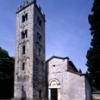DISCOVER ROMANESQUE: Province of Lucca Churches

Provincia di Lucca
12th century
At the heart of upper Versilia, at the gates of the village of Stazzema, in the municipal territory where a tragic Nazi slaughter occurred in August 1944, the pieve of Santa Maria Assunta rises in an isolated position, turning its back to the road and its front overlooking the crag at whose foothills the stream Vezza flows.

Provincia di Lucca
The pieve of San Martino is located in the hamlet named La Cappella, along the road that climbs from Seravezza to Azzano. Facing the marble quarries of Mount Altissimo, well-known by Michelangelo, and looking onto the valley of the Serra stream, with the sea in the distance, the pieve offers one of the most charming views of the whole upper Versilia.

Provincia di Lucca
12th century
Immersed among olive trees, partially concealing it from the sight of those who travel along the road below, the pieve of Santi Giovanni e Felicita in Valdicastello represented in the Middle Ages the northern boundary of the diocese of Lucca, bordering here on the diocese of Luni. Its jurisdiction covered a vast territory comprising the present municipalities of Pietrasanta and Stazzema.

Provincia di Lucca
12th century
The pieve of Santo Stefano in Vallecchia was built by the road leading from Pietrasanta to Seravezza, following the route of the old Via Francigena. In the Middle Ages it marked the southern boundary of the diocese of Luni, extending its jurisdiction over the whole territory of Seravezza.

Provincia di Lucca
12th century
A few kilometres from Camaiore, lying in the hills bordering the Via Francigena towards the sea, the locality of Pieve appears with its few houses, dominated by the church of Santi Giovanni Battista e Stefano. An ancient pieve with jurisdiction over a vast territory, it was built in its present form in the 12th century.

Provincia di Lucca
12th century
The Abbey of San Pietro, simply ‘the abbey’ (badia) for the inhabitants of Camaiore, is what is left of a Benedictine abbey reported ever since the upper Middle Ages and competing with the nearby pieve of Camaiore for the primacy of the oldest ecclesiastical institution of the area.

Provincia di Lucca
12th century
Lake Massaciuccoli and the sea open wide under the gaze of the Pieve of San Pantaleone, lying on a rise ‘in loco Illice’, ‘the place of ilexes’ which still enclose the church along with extensive olive groves.

Provincia di Lucca
12th century
Along the road leading to the Pieve of Brancoli, the small church of San Lorenzo strikes one’s attention for its bell tower, resting on an arcade through which the old road network once ran.

Provincia di Lucca
11th-12th centuries
Perched on the gentle slopes leading to the upland of Pizzorne, the pieve of San Giorgio di Brancoli looks onto the last stretches of the Serchio valley. From the church square, the gaze gets lost over the plain of Lucca; when the air is clearest, even the bell towers standing within the city walls of Lucca can be spotted.
























